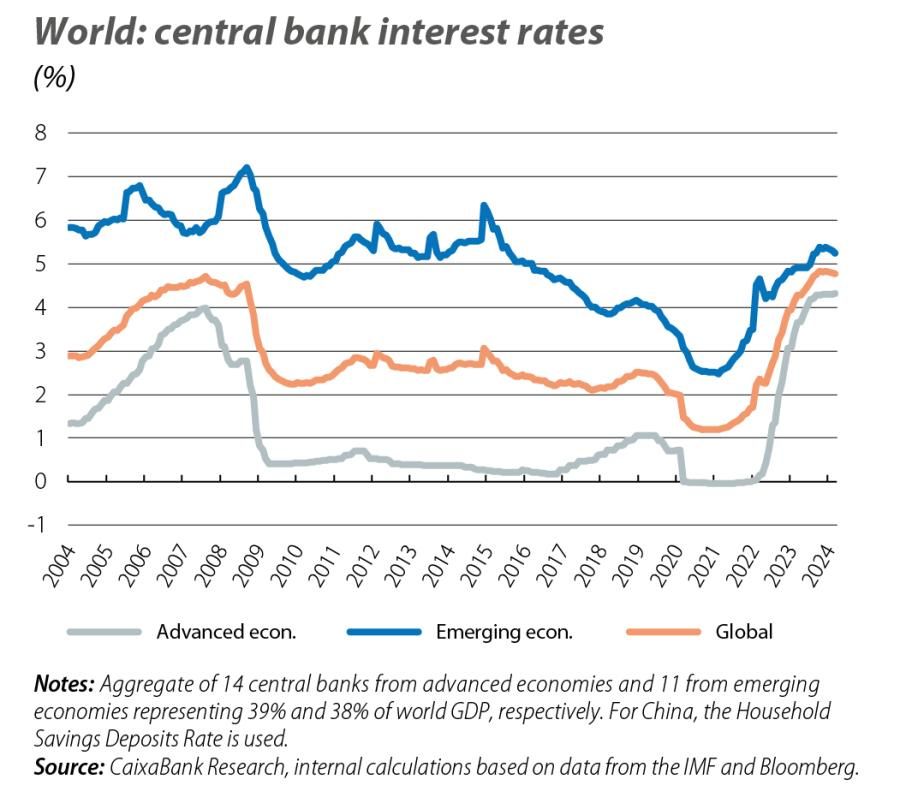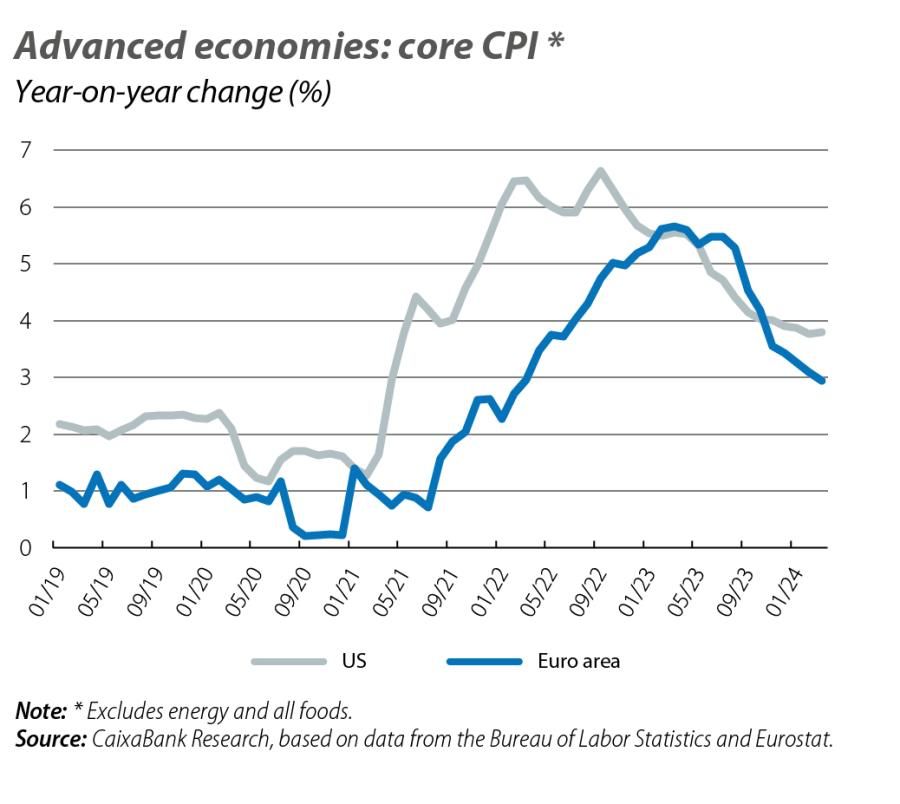Phase changes in monetary policy
The evolution of the economy points to a change of phase: the beginning of a relaxation of monetary policy worldwide.

Monetary policy is at an unusually restrictive point, resulting from the inflationary aftermath of the COVID-19 pandemic and the war in Ukraine which have raised our estimates for global interest rates above the peak reached in 2007. However, the evolution of the economy points to a change of phase: the beginning of a relaxation of monetary policy worldwide.
This change is clearly visible in the first chart and in the first rate cuts that have been introduced between late 2023 and early 2024 in Switzerland, Hungary, the Czech Republic, Mexico, Brazil, Colombia, Peru and Chile (most of which also led the cycle of rate hikes in 2021). One common factor behind these first cuts is the global decline in inflation, which has been significant compared to the peaks reached in 2022, although not yet definitive.

Idiosyncrasies and divergences
However, the trend of global disinflation and the change of phase in monetary policy hide disparities between countries. For example, the dynamics of the bloc of emerging economies are affected by the acceleration of inflation in Turkey (which stood at around 70% in early 2024, compared with rates of around 40% in mid-2023) and, to a lesser extent, Russia (almost 8% in recent months),1 while at the other extreme China has inflation levels close to 0% or even slightly negative.
- 1In addition to extreme cases such as Argentina, where inflation is running into three digits.

Among advanced economies, Japan is the most notable exception. The country’s inflation is also slowing down, but having been above 2% for two years now, the central bank has been able to take a different path and to begin raising interest rates. More subtle, but somewhat more prominent, is the divergence between the US and the euro area. On both sides of the Atlantic, the Fed and the ECB have pointed out that the gradual withdrawal of the restrictive monetary policy is approaching. Moreover, in both cases this stance is a response to a significant decline in inflation. But the recent dynamics are changing the tempos with which the Fed and the ECB plan to execute this monetary policy easing. As can be seen in the third chart, underlying price pressures in the euro area continue to decline at a steady pace, thanks to the fading of the direct and indirect energy and food shocks, as well as the absence of any significant second-round effects between prices, wages and business margins. In contrast, in the US, the underlying inflationary pressures have shown more resilience in recent months, driven up by both observed and owner-equivalent rents (a component which has not quite begun the sharp slowdown it was expected to follow according to most of the leading indicators) and, more recently, a certain acceleration in the prices of other services. The Fed continues to state that its next step will be a rate cut. However, the uncertainty over whether these tensions reflect temporary idiosyncratic factors or whether, in a context of robust economic activity, they are signs of an underlying resistance in prices is causing the Fed to be more cautious before making a move. On the other hand, in Europe the data are giving the ECB more cause for confidence and the communications pointing to a rate cut on 6 June are becoming increasingly explicit.

It is thus understandable that the financial markets have adjusted their expectations in recent months. Whereas, in Europe, they are assigning a 90% probability to a first rate cut in June and a total reduction of 75 bps is anticipated in 2024 as a whole, investors are not expecting the Fed’s first rate cut until November and they doubt whether there will be any further cuts before the end of the year. However, the distinction made by the markets regarding the outlook for each economy is not applicable to all aspects. In fact, the change in expectations in the financial markets has been quite widespread across the major advanced economies. At the end of 2023, investors had expected generally aggressive rate cuts and this vision has been corrected in favour of a more gradual easing.
ECB: data-dependence or Fed-dependence?
The synchronisation of investors’ expectations has several explanations (e.g., the possibility that US inflation and the Fed are anticipating the dynamics of other economies; financial markets’ tendency not to discriminate between the nuances of each region; etc.). In any case, it is reasonable to ask to what extent a more cautious Fed could affect the rest of the central banks. Focusing on the ECB, there are three main channels through which it could be affected: financial conditions, global demand and exchange rate. Firstly, restrictive conditions in the US will tend to strain those in the euro area. If this contagion is unwanted, it could reinforce the ECB’s determination to ease its monetary policy and keep European financial conditions in check. The two other channels, however, could favour a more cautious ECB. On the one hand, the strength of the US could boost global demand, put pressure on commodity prices and lead to an appreciation of the dollar. On the other hand, there is the threat of the impact that the exchange rate could have on inflation in the euro area, although estimates suggest that the transmission would be limited: a depreciation of 1% in the euro’s nominal effective exchange rate would push inflation up by less than 0.1 pp.2 Given that the euro has resisted against other currencies besides the dollar despite the latter’s strength,3 we could expect to see contained inflationary pressures even in the face of a weakening of the euro-dollar exchange rate to parity (and, in any case, lower pressures than the disinflation which is yet to be transmitted via other channels).

Throughout the readjustment of market expectations, the ECB has reiterated its independence from the Fed and has emphasised the different nature of the economic scenarios in the US and the euro area. Starting in June, and with the permission of a challenging risk map, the ECB will have the first opportunity to translate these words into rate cuts.
